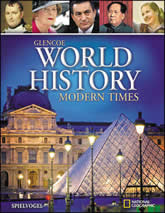
Glencoe World History Modern Times 2010Chapter 4: Toward a New WorldChapter OverviewsSection 1 Europe in the Middle Ages Elected pope in 1073, Gregory VII worked to reform the Catholic Church and assert papal power. Religious fervor prompted new monastic orders for men and women. The Inquisition gave the Church a tool for discouraging heresy. The importance of the sacraments for ordinary Christians gave the Church a central role in people's lives. The veneration of saints was also popular. Innovations in architecture made it possible to build soaring Gothic cathedrals. The first universities were established in Italy, France, and England as educational guilds. Although Latin was the universal language of medieval civilization, new literature—mainly poetry—was appearing in regional languages, such as French, English, German, and Spanish. Bubonic plague carried by rats infested with fleas decimated Europe's population in the mid-1300s. The plague devastated Europe's economy, led to anti-Semitism, and accelerated the end of serfdom. Church power declined as European kings rejected papal claims of supremacy. Faith in the papacy was undermined by the Great Schism, a nearly forty-year crisis during which a rival papacy was set up in France. The Hundred Years' War introduced new methods of warfare, and devastated England and France. The "new monarchies" of the late 1400s reestablished their centralized power in England, France, and Spain. Section 2 Early American Civilizations The Chavin, Nazca, and Moche cultures prospered in the region of Ecuador and Peru. The Inca started as a small community high in the mountains of Peru. In the 1440s, they launched a campaign of conquest that eventually brought the entire region under their control. The Inca emperor controlled an army of 200,000 soldiers and a highly centralized government. Inca society was highly regimented, with clearly defined roles for women. Terraced farms were a source of livelihood for most people. The Inca built impressive cities—such as Cuzco and Machu Picchu—and roads spanning nearly 25,000 miles. Although they had no writing system, they kept records using a system of knotted strings called the quipu. |  |















